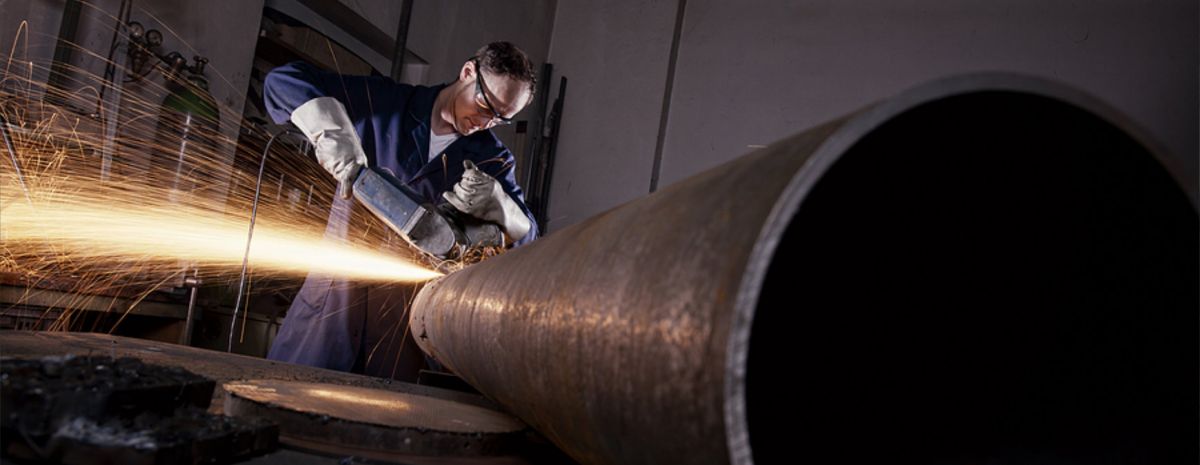TWS is a Great Training Option for Everyone
Learn more about how we can prepare you to advance your career.
It’s important for a pipefitter to know how to measure, cut and bend piping materials, since
a pipefitter’s job includes installing pipes and fixtures in commercial buildings. These pipes carry the water, gas, chemicals and other important substances that we rely on to function as a society.1
One of the first things students might learn in pipefitter training is how to use the right tools to accomplish these tasks.
Measuring tools can be some of the most important items in a pipefitter’s toolbox.2
Have You Considered a Career in the Skilled Trades?
Fill out the form to recieve a no obligation info packet.
See how 8 pipefitter measuring tools work below.
Measuring Tools That Pipefitters Use
Cutting, assembling and installing pipes requires a strong working knowledge of industry tools. What tools do pipefitters use to measure and mark pipes?3 Here are eight measuring and marking tools that pipefitters use.
1. Steel Rule
One of the simplest but most essential tools in any pipefitter’s toolkit is the steel rule, otherwise known as a ruler. This steel rule is a measuring tool that helps a pipefitter make accurate measurements using predefined markings, like inches and centimeters. A steel rule can be rigid or flexible, and can be used as a guide for laying out lines. A very rigid steel rule could even be used as a guide for cutting.4
2. Circumference Rule (aka Tinners Rule)
A circumference rule, also known as a tinners rule, has a regular measuring scale on the top edge like a steel rule, with the added functionality of circumference measurements on the bottom edge. The top edge can be used to measure the diameter of a pipe, while the bottom can be used to determine the circumference. A circumference rule is especially useful for fabricating around ducts, ducting, pipes and tubes.5
3. Straight Edge
A straight edge differs from a ruler because it has no marking for measurement. Instead, a straight edge is a long wooden or metallic instrument with a perfectly flat edge, used to check the straightness of lines or to maintain an undeviating linear path.6 Straight edges can come in different materials, sizes, weights and lengths.7
4. Scriber
Once a pipefitter measures lines for cutting, they might use what is called a scriber to mark the lines. A scriber is like a pen for metalworkers. It is a hand tool used to mark lines on metal. A scriber is made of a rod with a tip of cast steel that has been hardened and sharpened to a point. A scriber leaves a mark by dragging the point over the metal to create a shallow scratch. A scriber is used rather than a pen or pencil because regular ink lines are too easily erased and hard to see.8
5. Scribing Compass (aka Divider)
A scribing compass, also called a divider, helps pipefitters accurately mark and measure, inscribe circles and arcs, and can also be used to measure distances.9,10
6. Trammel
A trammel is a tool used to draw circles and arcs that are larger than can be drawn with a divider or compass. They can also be used to bisect lines and angles.11
7. Prick and Center Punch
A punch is a tool with a hard metal rod with a narrow tip at one end and a flat area on the other end. The tip is strategically placed on a surface, and the flat end is hammered down to create a small hole or indentation on the workpiece. A center punch is used to mark the center of a point, which can help guide a drill and prevent it from straying.12 A prick punch is used for marking out, or creating a dimple, in a piece of metal to guide a pattern or cutting.13
8. Try Square
A try square is a tool used for measuring and marking a square piece of material. The square can be used to determine the accuracy of a 90-degree angle. It’s called a try square because it is used to “try” the squareness of a workpiece.14 A pipefitter’s square can be used to check the squareness of one surface to another, find the center line of the pipe, determine arc length for a radius and more.15
Learn More About Pipefitter Tools in Pipefitting Training

These are just eight types of measuring tools that pipefitters use to measure and mark the dimensions of pipes before installing, cutting and assembling. There are lots of different types of tools for different purposes, like:
- Supporting tools
- Holding tools
- Striking tools
- Cutting tools
- Tightening tools16
A pipefitter’s job can be exciting and complex. There is a lot to learn, from using different tools to reading mechanical drawings, to troubleshooting malfunctioning systems.1
Did this brief list of pipefitter measuring tools spark your curiosity? If you want to learn more about all the different facets of a pipefitter career, contact Tulsa Welding School to learn about our Professional Welder with Pipefitting training program. Call (855) 237-7711 to learn about enrollment!
1https://www.bls.gov/ooh/construction-and-extraction/plumbers-pipefitters-and-steamfitters.htm#tab-2
2http://www.pipefitterslocal211.com/three-skills-need-succeed-pipefitter/
3https://www.betterteam.com/pipe-fitter-job-description
4https://www.fine-tools.com/stahlmassstab.html#:~:text=Steel%20rules%2C%20also%20called%20rulers,any%20shop%20when%20accuracy%20matters.&text=While%20their%20primary%20purpose%20is,measure%20rounded%20or%20cambered%20work.
5https://www.geionline.com/rulers/tinners-circumference-ruler/2027a-48/
6https://youtu.be/W7iXuROgZB0
7https://www.fine-tools.com/G307944.html
8https://en.wikipedia.org/wiki/Scriber
9https://www.pipingengineer.org/common-tools-and-equipments-used-in-piping-fabrication/
10https://www.mcmaster.com/compass-scribers/
11https://brainly.in/question/8114095
12https://en.wikipedia.org/wiki/Punch_(tool)
13https://store.curiousinventor.com/product/prick-punch/
14https://en.wikipedia.org/wiki/Try_square
15https://www.mathey.com/Pages/tool-pipefitters-square.htm
16http://www.engineersgallery.com/tools-used-fitting-shop/
This blog has been labeled as archived as it may no longer contain the most up-to-date data. For a list of all current blog posts, please visit our blog homepage at https://www.tws.edu/blog/







